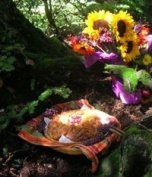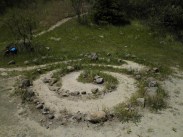The need for design thinking in small “at a distance” programs …
Lezlie Kinyon (also published in Pagans in H igher Education [Files]) ·
igher Education [Files]) ·
Over the past two years, I have been asked to teach basic psychology and systems design courses at four different “start-up” at-a-distance graduate programs. I have been asked to do this through professional contacts either through my graduate school, Saybrook, or through other organizations that I have affiliations for. Each time, the referral came through a trusted colleague, and that trust became the final portion of the agreement to accept the offer. Save one, which I turned down flat out, and has no bearing on this conversation as it was/is a for-profit program. The other three programs are the reason why I am writing this brief editorial in this blog. (Please share your experiences in the comment area.) In the spiritual “higher-ed” world, particularly as it attempts to cater to the needs of minority faith and indigenous peoples for training in pastoral needs, this issue is most relevant. In the past decade various independent, small graduate programs have appeared at the Master’s level looking to fill a perceived need within this population of scholars to staff, and to enroll as students, in programs offering “Goddess-oriented” and “Earth-centered” spirituality programs. Often attached to liberal seminaries and the smaller private, nonprofit, graduate programs that specialize in transpersonal psychology, these programs are also – very often – under funded and understaffed. It will reward the potential student or faculty seeking these programs to undertake – first and foremost – a program of research about both the program in question, and the current models of successful at-a-distance learning in higher ed, before approaching these programs as anything like serious attempts at collegiate learning.
All of these programs suffered – categorically – from a model of distance learning that is both incomplete, and, in the long, run self-defeating. While many of these conditions also exist for campus-based “brick & mortar” programs, they seem particularly relevant to discuss as the popularity of distance-learning models are adopted by small start-up programs and smaller departments in large universities as a means to cut costs. In brief, each program:
- … offered payment to faculty that is so far below the accepted standard (even for adjunct teaching) that it is under the category of “volunteer work” for most qualified faculty
- … so few students are enrolled in the program that no guarantee of enrollment in the course is offered, nor is the payment equal to the hours of prep work or actual student-faculty interactions. Save for a tiny portion of professionals, this is neither cost nor time-effective.
- … non-accreditation. This may be problematical for start-up programs attached to a larger research oriented institution or for those who have developed a good reputation, for others it becomes a “minus” on the CV regarding future positions and research granting bodies. (It is certainly trouble for students enrolled who hope to continue on in higher ed as a career or in doctoral and post-doc programs.)
- … little or no faculty support (no development or “in suit” training offered, no clerical support, no coverage of copyrighted material usage fees)
- … the program offered no ombudsman nor any other method of resolving conflicts or disputes
- … a non-collegial – and, in one instance hostile – working environment
- …and, finally, (and most importantly) an incomplete model of distance learning that is – increasingly – reliant on unproven or cumbersome technological solutions as a substitution for face-to-face class time.
This last item, coupled with technical personnel who display that certain “techie arrogance” which creates failure within programs in all sectors of business and education in both visible and invisible ways. In one psych program I agreed to teach a course in (reluctantly, it must be admitted here: a “once burned twice shy” situation) the model had very little visible basis in design thinking, and resulting in a mid-term resignation because the “classroom time” solution provided by the institute did little more than get in the way of the actual teaching and left myself as well as at least one student nearly to tears in frustration in attempting to find “work a rounds” with no actual assistance from the program’s developers or technical staff. When I found myself asked to find and pay for a solution on my own -and, did so, out of pocket – the final decision was to cancel the course without further discussion. This situation became so badly addressed on every level, that seeing no recourse, and no alternatives with positive outcomes on any level, I immediately resigned.
This was not the worst of the programs, the first I had agreed to “fill in” with a needed psychology class sent a syllabus that had no freedom for interpretation whatever, did not provide any prep time, and when the contract was sent finally, (after months of waiting) assigned no students to the course: faculty are, apparently, part of the “recruiting” mechanism for obtaining student enrollment in the program! This method of recruitment is – although questionable at best – not unheard of and one that all potential faculty should thoroughly research before agreeing to anything. (Needless to say, I did not sign the contract.)
From a Human Systems perspective, all of these issues can (and, should) be addressed from a design perspective. The people creating these programs are, very often, well-meaning, educated, and – to a fault – passionately working, even sacrificing personal life and professional goals, to create programs that are both academically interesting and meeting a perceived need. The failure point, in each case, has been in the distance-learning model used by the program. Until that is addressed, each of these programs will continue to struggle for acceptance, an adequate financial foundation to work from (faculty research grants, endowments, etc. etc.) qualified faculty, and student success in the world-beyond-graduate-school.





